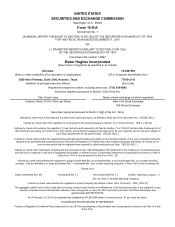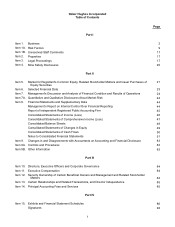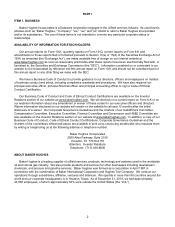Baker Hughes 2015 Annual Report Download - page 18
Download and view the complete annual report
Please find page 18 of the 2015 Baker Hughes annual report below. You can navigate through the pages in the report by either clicking on the pages listed below, or by using the keyword search tool below to find specific information within the annual report.9
Based upon current information, we believe that our overall compliance with environmental regulations,
including routine environmental compliance costs and capital expenditures for environmental control equipment, will
not have a material adverse effect on our capital expenditures, earnings or competitive position because we have
either established adequate reserves or our cost for that compliance is not expected to be material to our
consolidated financial statements. Our total accrual for environmental remediation is $35 million and $35 million,
which includes accruals of $2 million and $3 million for the various Superfund sites, at December 31, 2015 and
2014, respectively.
We are subject to various other governmental proceedings and regulations, including foreign regulations,
relating to environmental matters, but we do not believe that any of these matters are likely to have a material
adverse effect on our consolidated financial statements. We continue to focus on reducing future environmental
liabilities by maintaining appropriate company standards and by improving our assurance programs.
ITEM 1A. RISK FACTORS
An investment in our common stock involves various risks. When considering an investment in Baker Hughes,
one should carefully consider all of the risk factors described below, as well as other information included and
incorporated by reference in this annual report. There may be additional risks, uncertainties and matters not listed
below, that we are unaware of, or that we currently consider immaterial. Any of these may adversely affect our
business, financial condition, results of operations and cash flows and, thus, the value of an investment in Baker
Hughes.
Risk Factors Related to the Worldwide Oil and Natural Gas Industry
Our business is focused on providing products and services to the worldwide oil and natural gas industry;
therefore, our risk factors include those factors that impact, either positively or negatively, the markets for oil and
natural gas. Expenditures by our customers for exploration, development and production of oil and natural gas are
based on their expectations of future hydrocarbon demand, their expectations for future energy prices, the risks
associated with developing the reserves, their ability to finance exploration for and development of reserves, and
the future value of the reserves. Their evaluation of the future value is based, in part, on their expectations for
global demand, global supply, spare productive capacity, inventory levels and other factors that influence oil and
natural gas prices. The key risk factors we believe are currently influencing the worldwide oil and natural gas
markets are discussed below.
Demand for oil and natural gas is subject to factors beyond our control, which may adversely affect our operating
results. Changes in the global economy could impact our customers’ spending levels and our revenue and
operating results.
Demand for oil and natural gas, as well as the demand for our services, is highly correlated with global
economic growth, and in particular by the economic growth of countries such as the U.S., India, China, and
developing countries in Asia and the Middle East who are either significant users of oil and natural gas or whose
economies are experiencing the most rapid economic growth compared to the global average. Weakness or
deterioration of the global economy or credit markets could reduce our customers’ spending levels and reduce our
revenue and operating results. Incremental weakness in global economic activity, particularly in China, India,
Europe, the Middle East and developing countries in Asia, could reduce demand for oil and natural gas and result in
lower oil and natural gas prices. Incremental strength in global economic activity in such areas will create more
demand for oil and natural gas and support higher oil and natural gas prices. In addition, demand for oil and natural
gas could be impacted by environmental regulation, including cap and trade legislation, regulation of hydraulic
fracturing, carbon taxes and the cost for carbon capture and sequestration related regulations.
Supply of oil and natural gas is subject to factors beyond our control, which may adversely affect our operating
results.
Productive capacity for oil and natural gas is dependent on our customers’ decisions to develop and produce oil
and natural gas reserves and on the regulatory environment in which our customers and we operate. The ability to
produce oil and natural gas can be affected by the number and productivity of new wells drilled and completed, as
well as the rate of production and resulting depletion of existing wells. Advanced technologies, such as horizontal
























